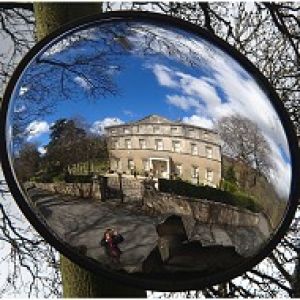Water tower at Lytes Carey manor
After the previous day's dreariness, the blue skies boded well for blipping. We had to leave our lovely B&B in Dorchester this morning, and so we headed off over the hills, via Hardy's monument (the admiral, not Thomas, the writer) to the picture-postcard village of Abbotsbury, near the coast. I'd always wanted to visit the swannery. It was there that the world's first homosexual swans were discovered, apparently. Alas, there were no swans, breeders or otherwise, to be seen, as it is closed until March.
Fortunately, the subtropical gardens were on my list too, and we stepped through the ticket barrier into a colonial world of tall palms and roses, magnolias and camellias tumbling down terraces gving on to exquisite vistas. One of my favourite gardens is Le Rayol, on the Cote d'Azur, which aims to showcase plants from several climate zones, in a perfect coastal setting. Think of Cornwall or corners of Portmeirion, but with better weather, and you might just catch my gist, but it's better far to go there in person, with a camera.
The hours flew by there, and after a disastrous attempt at lunch in the too-busy cafe (it's half term, and all the little Noahs in the world and their grandparents were there too, with the staff entirely unprepared for the deluge), we drove down to Chesil beach. Steve had to stay in the car; otherwise I'd have spent an hour there, blipping the coast, the sunshine, the pebbles, the sheep, the trees, and the sheer Dorsetiness of Dorset.
Our next stop was in Somerset, and we arrived at Lytes Carey manor not long before sunset. I'd bought a huge book of National Trust house-porn on my visit to Montacute House on Saturday, so I knew we were going to see a pretty little Tudor manor house with a garden and estate, near the river Carey. (Link to someone else's Flickr images of the house and gardens https://www.flickr.com/search/?text=lytes%20carey%20manor
Naturally the house and gardens were closed, what with it being winter and sunset, but we had a wonderful times poking and prying around, pointing our lenses through locked gates, and jumping over irrigation ditches. Dog walkers were out in force, lured by the late evening light. I shall have to return when it's open, to see the inside of the house and the famous apostle garden of topiarised yew trees. I liked the scale of the buildings: not as grand, cold or highly-glazed as Montacute house. Henry Lytes lived there, and translated an early herball into English, for he believed that access to herbal medicinal knowledge should be available to all. There were plenty of people at that time, though, who could neither read nor afford to buy books. I have ordered an historical novel for myself about the place. it's called The Knot by Jane Borodale. See http://www.amazon.co.uk/The-Knot-Jane-Borodale/dp/0007313330/ref=tmm_pap_title_0 I shall report back in due course. I think I'd like to write a novel based around a historical house, too, but I haven't the faintest idea how to go about it! All my writings so far have centred on the 20th and 21st centuries.
After leaving Lytes Carey, we drove through the village where my father went to school, which is odd in itself because I have had so little contact with my father, ever. It was half term so I could not pop in to ask if they'd heard of him since the millennium (this is something we are working on as a family: establishing who last had contact with him. So far, his old school is winning. If anyone else has seen him at all recently, please get in touch. He's the tall one with the tremor and the foreign accents collection).
I forgot to say that this picturesque water tower, blipped above. was in fact built in 1923 so is not ancient, though listed. It's a pumping station with a hose coming out of it connected to a drinking trough for animals, though it may well serve other purposes. I could hear the machinery humming away inside. It's a copy of a similar structure at Avebury or Lacock Manor.
We were happy to see Bomble and our own bed again, but sad that we'd had such a short trip away. On my return, I received a text from my good friend Tess (named after Tess of the D'Urbervilles) to say that she had actually passed us while driving over the hills by the Hardy monument! Drat and drat again!
Once more unto the beach, I say....

Comments
Sign in or get an account to comment.


